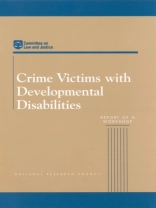Although violent crime in the United States has declined over the past five years, certain groups appear to remain at disproportionately high risk for violent victimization. In the United States, people with developmental disabilitiessuch as mental retardation, autism, cerebral palsy, epilepsy, and severe learning disabilities may be included in this group. While the scientific evidence is scanty, a handful of studies from the United States, Canada, Australia, and Great Britain consistently find high rates of violence and abuse affecting people with these kinds of disabilities.A number of social and demographic trends are converging that may worsen the situation considerably over the next several years. The prevalence of developmental disabilities has increased in low-income populations, due to a number of factors, such as poor prenatal nutrition, lack of access to health care or better perinatal care for some fragile babies, and increases in child abuse and substance abuse during pregnancy. For example, a recent report of the California State Council on Developmental Disabilities found that during the past decade, while the state population increased by 20 percent, the number of persons with developmental disabilities in California increased by 52 percent and the population segment with mild mental retardation doubled. Because of a growing concern among parents and advocates regarding possible high rates of crime victimization among persons with developmental disabilities, Congress, through the Crime Victims with Disabilities Awareness Act of 1998, requested that the National Research Council of the National Academy of Sciences conduct a study to increase knowledge and information about crimes against individuals with developmental disabilities that will be useful in developing new strategies to reduce the incidence of crimes against those individuals. Crime Victims with Developmental Disabilities summarizes the workshop and addresses the following issues: (1) the nature and extent of crimes against individuals with developmental disabilities; (2) the risk factors associated with victimization of individuals with developmental disabilities; (3) the manner in which the justice system responds to crimes against individuals with disabilities; and (4) the means by which states may establish and maintain a centralized computer database on the incidence of crimes against individuals with disabilities within a state.
Commission on Behavioral and Social Sciences and Education & Committee on Law and Justice
Crime Victims with Developmental Disabilities [PDF ebook]
Report of a Workshop
Crime Victims with Developmental Disabilities [PDF ebook]
Report of a Workshop
Achetez cet ebook et obtenez-en 1 de plus GRATUITEMENT !
Langue Anglais ● Format PDF ● Pages 104 ● ISBN 9780309513692 ● Éditeur Joan Petersilia & Joseph Foote ● Maison d’édition National Academies Press ● Publié 2001 ● Téléchargeable 3 fois ● Devise EUR ● ID 7150096 ● Protection contre la copie Adobe DRM
Nécessite un lecteur de livre électronique compatible DRM












